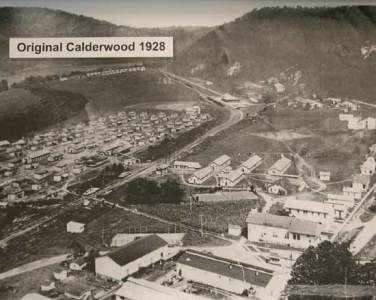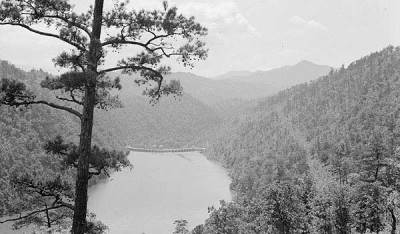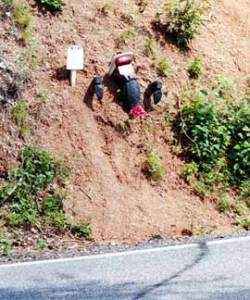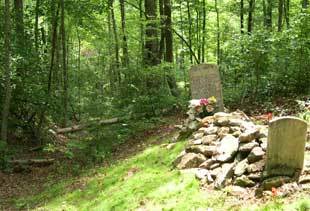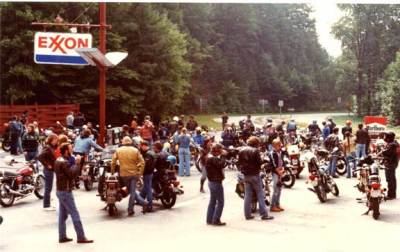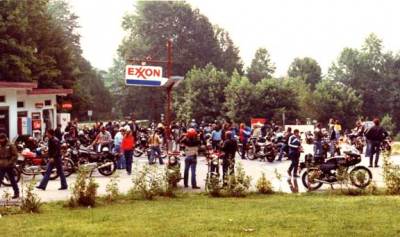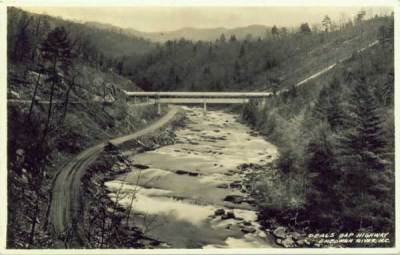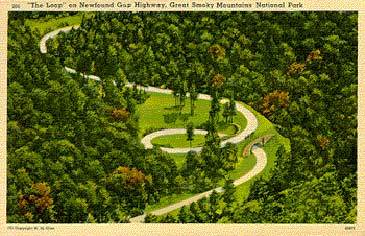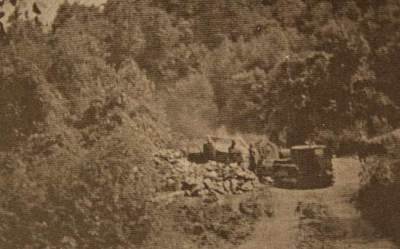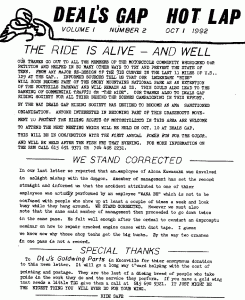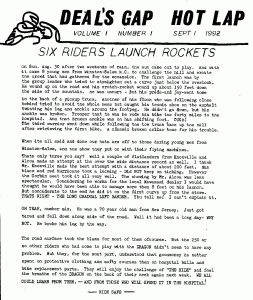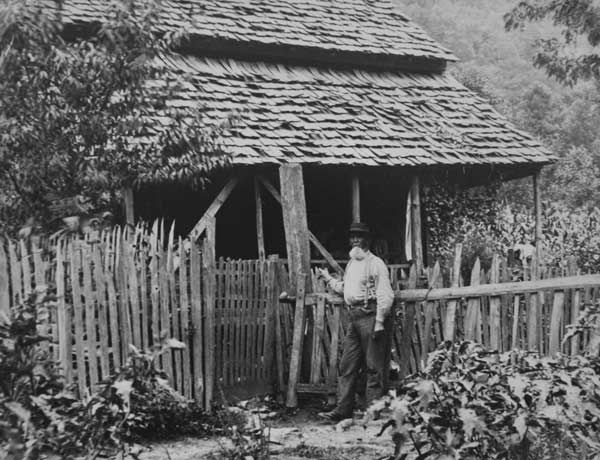
The earliest known photo on the Tail of the Dragon. This is the Toll Booth that was located at mile marker 3 circa 1890s. The road had been known at various times as Parsons, Madisonville/Franklin and the Tallassee Turnpike. George Davis was the Tollkeeper.
Tail of the Dragon History
by Ronald E. Johnson
The Tail of the Dragon, also known as Deals Gap or just the Dragon, is considered by many as one of the world's best motorcycling and sports car roads. Anyone looking for an exciting piece of asphalt will enjoy this stretch of US 129 at the Tennessee/North Carolina state line. Route 66, which gained notoriety because of the popular 1960’s television show, is perhaps the most well known road in America. It stretched thousands of miles from Los Angeles to Chicago, but today only short segments remain. But the Dragon is only 11 miles long and someday might surpass the mystical legends of that famed route.The Dragon has a notorious past. Much of the route was originally just an animal track worn down by large herds of buffalo and then used by native American Cherokee Indians for centuries. The first white men to use the trail were hunters and trappers moving into dangerous territory in the early 1700s. In 1756 British soldiers struggled through the mountain gaps to establish Fort Louden, one of the first outposts west of the Appalachian mountains. The fort was attacked by Indians in 1760 forcing the few surviving soldiers to retreat.
At some point there was a small outpost/store located near the North Carolina/Tennessee State Line. The Deal family owned and operated it, hence the map designation of Deals Gap. The family later moved west to a more hospitable location.
In the early 1800s the path became a crude roadway used to access the extremely remote settlement of Cades Cove via the Parsons Branch Road. Today this 8-mile gravel road still exhibits some of the excitement of the early days with 19 water fords. But note that the Parsons Branch Road is “one-way” out of Cades Cove to the Dragon. This route suffered severe damage in the floods of 2002 and was closed several years for repairs. As of 2020 the road is closed once again, this time due to dangers from dead trees falling.
There were many conflicts between the Cherokee and white settlers who infringed upon their world. Both sides took lives in needless disputes and petty quarrels. This undeclared warfare resulted in one of the saddest events in our early American history – the Trail of Tears relocation of the Cherokee to Oklahoma. Many Native Americans refused to assemble and leave the only land they had ever known. The Dragon was one of the remote paths they used to evade the Army sent to capture them.
The Civil War brought more bloodshed to the Dragon and surrounding areas. There is a grave-site located at mile 6.5 of the Dragon giving testimony to the times. It is where Bas Shaw was buried after being killed by Confederates as he was transported to prison in Asheville. There are likely many more buried in the nearby mountains in unmarked graves.
Gangs, such as the Kirkland Bushwhackers, often attacked Northern patrols and anyone else who happened their way. They killed two of Bas Shaw's sons nearby. The forested mountains offered the perfect hiding place to escape detection. And the law was reluctant to venture after them.
As more settlers moved into the area landowners began collecting tolls for use of the road. Toll Booth Corner, located at mile 3.0, was a place to pay for the right to cross private property. There were corrals to keep the livestock in transit and meager sleeping quarters for guests to spend the night. Some who tried to cross without paying the toll were caught and supposedly hanged on the spot.
Circa 1913 a town was actually born on the Dragon. Calderwood, formerly the Howard farm property, was created as living quarters for employees constructing Cheoah Dam in 1917, Calderwood Dam in 1930, and those workers who later maintained the entire system. A railway ran from Knoxville, through Calderwood, and followed the Little Tennessee River all the way to Tapoco in North Carolina. Equipment, supplies and workers were transported on this line. Calderwood was also used by Alcoa Aluminum, aka Tapoco, Inc. as a corporate retreat for their executives. There was even a golf course accessed by ferry across the Little Tennessee River. Today’s Tapoco Lodge was also built by Alcoa for their executives. The entire dam and reservoir system provided electric power to Alcoa’s large aluminum processing plant north of Maryville, Tennessee.
The Dragon in the late 1920s was designated as TN72 on the Tennessee side and NC288 on the North Carolina side (today’s NC28 to Fontana). Completion of the bridge near Tapoco in 1931 allowed connection of NC108 to NC288. In 1934 NC 108 and TN72 was renumbered as US129 and was most likely paved for the first time around that date.
The new road was only lightly traveled for decades, primarily by locals, hunters and lost tourists. The small motel and diner went through many different owners from the 50s to the 90s. It was owned by the Moodys, the Craftons and was known after that as Macs Motel and later The Crossroads of Time. Today it is Deals Gap Motorcycle Resort.
In 1992 Doug Snavely, hearing about a great ride in the Smokies, came up from Road Atlanta to ride US129 for himself. The ride proved even more exciting than he had ever imagined. He met Pete, owner of the Crossroads of Time, a small café/motel located at the junction of US129 and NC28. At the time Pete catered to fishermen, hunters, and the few lost vacationers. Doug sold Pete on promoting the road to motorcyclists and got a job as manager at the Crossroads.
Snavely began to publish the monthly Deals Gap Hot Lap newsletter on September 1, 1992. He also got the road mentioned in Rider Magazine. Snavely was not welcomed by everyone. He received many threats and was even shot at once as he rode down one of the local roads.
Snavely also created the Deals Gap Riding Society. There were some 350 members from all over the United States. The organization more or less folded when Snavely left the Crossroads of Times after a few years. He lived in Knoxville and later moved to Virginia. He occasionally returns to ride the Gap.
In the next few years motorcycle riding increased dramatically at the Dragon. Each year since then the number of motorcycles and sports cars has seemingly doubled. Today riders and drivers from across the US, Canada, and many foreign countries come to test their riding skills on the Dragon. There is always a show on the weekends from April through October.
The Dragon, as many have found, is truly a unique road. In 14 miles there are only two intersections; NC28 to Fontana Dam and the lightly traveled gravel road at Parsons Branch. There are no buildings other than the Tail of the Dragon T-shirt Shack and Deals Gap Motorcycle Resort. There are 318 curves in the 11 miles located on the Tennessee side. Most of the time there is very little traffic and the vehicles that do use this road are primarily motorcycle riders and sports car drivers looking for the thrill of their lives. It is remote - there is very little evidence of human population within 20 miles in any direction. Most of the roadway is bounded by United States Forest Service property, the Great Smoky Mountains National Park, and forested land owned by Alcoa Aluminum who operates the dams located along US129.
Deals Gap, the name that many riders know the Dragon by, is actually the gap in the mountains that the road follows. Deals Gap, located at the North Carolina and Tennessee State Line, is the highest point on the Dragon at 1962 feet above sea level. It was likely named for one of the early families who settled here.
The road is still desolate today and can be a real adventure in the winter months. We've had to deal with bears, wild boars, deer and turkeys in the road, trees down, snow/ice, storm debris and tractor-trailers taking-up both lanes in the curves. It is not a road for the squeamish, but if you're looking for a little excitement don't miss this one.
We've been driving and riding the Tail of the Dragon since 1975. At first it was in the family car and then in our 1976 Corvette. Now we have graduated to motorcycles. We have always loved the road, finding it a hoot in whatever we happen to be driving. One of the most exciting rides was in our SUV over icy roads in 4-wheel drive.
In the summers we ride the Dragon at least twice a week. It's better than any roller coaster we have ever been on. Our favorite sections are the Hump, the Chicanes, and the Esses just before Cattail Straight. Be ready to scrape some metal or squeal your tires in some of these wild curves. Traffic is usually light on weekdays and heavier on good weather week-ends.
The Tail of the Dragon gained popularity after the website www.TailoftheDragon.com went on-line in 2000. This site, run by Ron and Nancy Johnson of Robbinsville, offers T-shirts, souvenirs, photos, maps, and advice on how to survive at the Dragon.
To those coming from the North Carolina side, the Dragon begins at Fugitive Bridge with a view of the Cheoah Dam where Harrison Ford jumped in the movie The Fugitive. It ends 14 miles across the mountain at the Tabcat Creek Bridge in Tennessee. From Fugitive Dam US129 climbs through The Slide, a steep series of "S" curves where one would not want to meet one of the tractor-trailers that comes this way at times. The road then levels and straightens until a series of curves approaching the Crossroads of Time, one of the main hangouts for visitors. Next comes Deals Gap and the Tennessee State Line. For the next eleven miles most people just remember curve after curve after curve and surviving the run of their lives.
After riding many other twisties, we always come home to the Dragon and rate it the best of them all.
In addition to the 1993 The Fugitive, three other movies have been filmed along this road. The first feature film made on US 129 was Thunder Road. This 1958 Robert Mitchum film about backwoods moonshining had scenes at the power line easement at about mile 4.5 on the Dragon map and you can see the old wooden "safety" posts on the corner. A few of the posts still remain.
Part of the 1971 classic movie Two-Lane Blacktop was filmed on the Dragon. There are scenes of the state line sign, some of the curves, the old Esso Gas Station, Crafton's Motel and Café, along the Little Tennessee River and the original single lane bridge at Tapoco Dam. These scenes are at the end of the movie.
Part of In Dreams (1998) with Annette Bening was filmed on Moonshiner 28, Tapoco Dam and Calderwood Dam.
The Tail of the Dragon may have a checkered history, but today it is becoming “the destination” for hundreds of thousands of riders, drivers, and even bicyclists looking to tame the beast.
Additional Historical Information:
- The Complete History of US 129 from Chiefland, Florida to Knoxville, Tennessee
by Ron Johnson 2020 - "The Historical Tail of the Dragon"
by Ron Johnson, published in American Road Magazine, Vol. 4, Number 4, 2007 - DOT specifications (pdf)
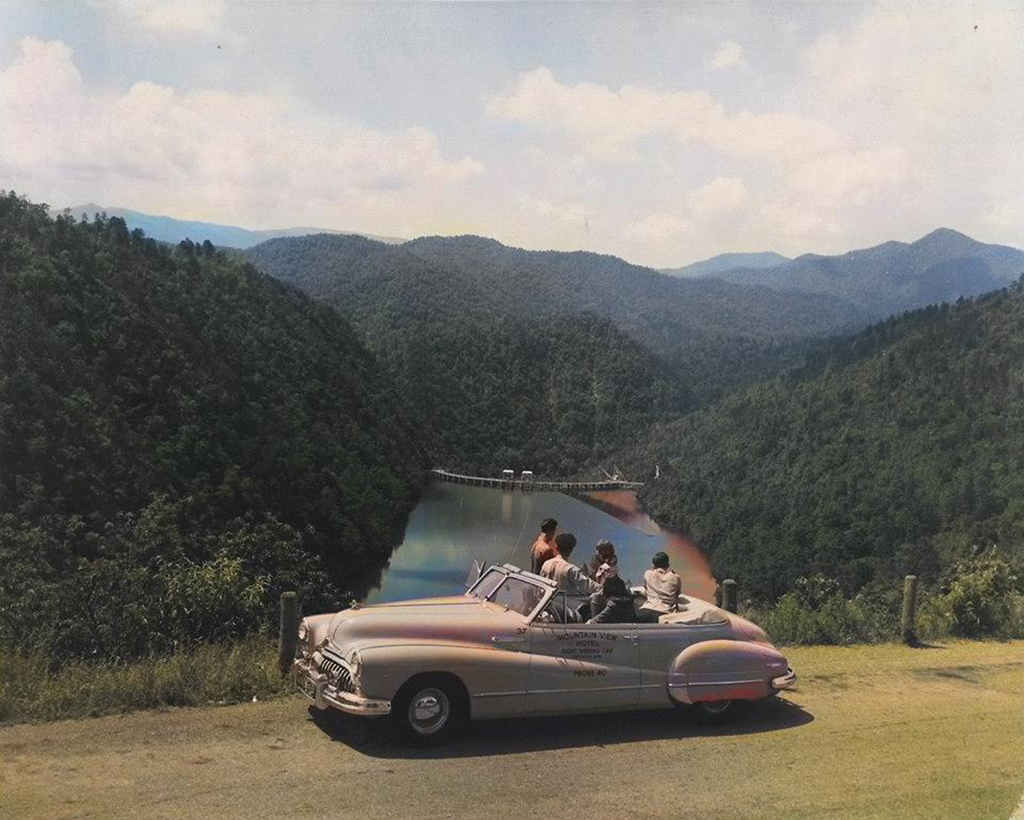
1947 Mountain View Hotel Buick Super Convertible at Overlook
Historical Dragon Photos:
Click on image for description and larger view
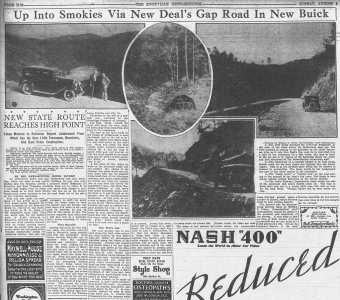
While researching news articles for my History of the Tail of the Dragon I recently found this 1929 article by an adventurous reporter. He took a new 1930 Buick Standard Six Sedan on the uncompleted US 129. Photos include a view at the Calderwood Overlook, a wood structure to be concreted spanning Rabbit Creek (Parsons Branch), the hairpin corner at The Whip, and the roadside camp for construction workers. The grand opening was still six months away.
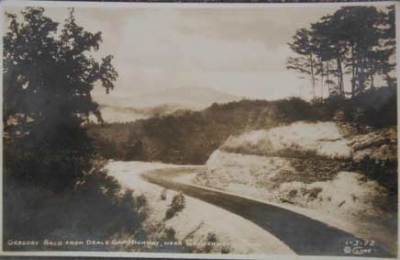 The location of this postcard photo is about mile marker 9.2 looking easterly from the southbound lane. We believe this postcard dates to the early 1930s. It is labeled Gregory Bald from Deals Gap Highway, near Calderwood, Tenn. It is not identified as US 129. The roadway has new pavement and the sides of the road appear freshly graded. The numbers 1-3-72 do not make sense as a date for the postcard. We drove the road in the 70s and it did not look anything like this.
The location of this postcard photo is about mile marker 9.2 looking easterly from the southbound lane. We believe this postcard dates to the early 1930s. It is labeled Gregory Bald from Deals Gap Highway, near Calderwood, Tenn. It is not identified as US 129. The roadway has new pavement and the sides of the road appear freshly graded. The numbers 1-3-72 do not make sense as a date for the postcard. We drove the road in the 70s and it did not look anything like this.
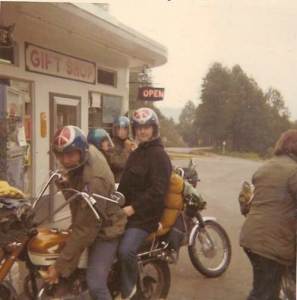 I thought you might be interested in a picture of me and my friends on our 350 Hondas in 1971 in front of what is now the the Deals Gap MC Resort (then Craftons Motel and Restaurant). We had pancake beakfast there after camping by the river at the other end of the Dragon. One of my buddies had to lay his bike down when some guy pulled across his lane turning off to Calderwood. He and his fiance weren't hurt and the bike suffered only minor damage. Bob Miller TOD: Note the Peace Symbol helmets
I thought you might be interested in a picture of me and my friends on our 350 Hondas in 1971 in front of what is now the the Deals Gap MC Resort (then Craftons Motel and Restaurant). We had pancake beakfast there after camping by the river at the other end of the Dragon. One of my buddies had to lay his bike down when some guy pulled across his lane turning off to Calderwood. He and his fiance weren't hurt and the bike suffered only minor damage. Bob Miller TOD: Note the Peace Symbol helmets

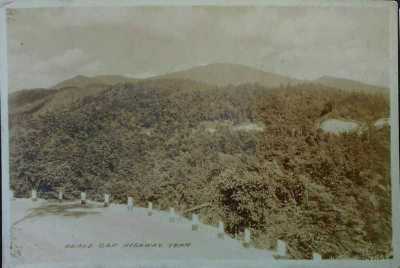
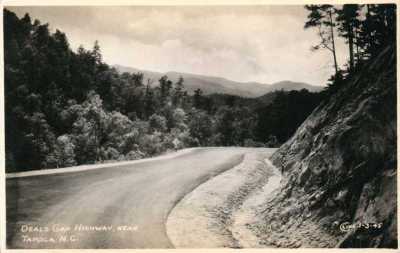
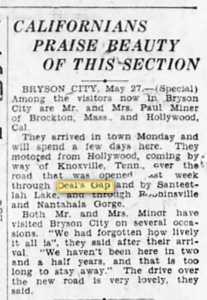
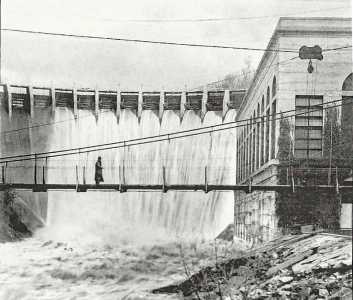
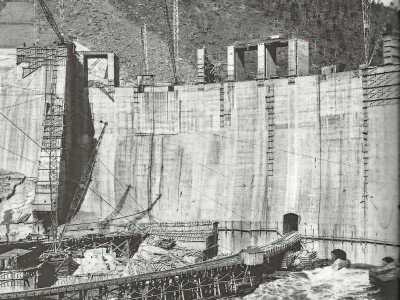
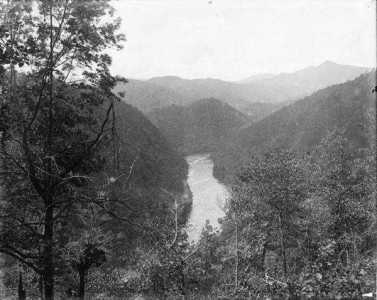
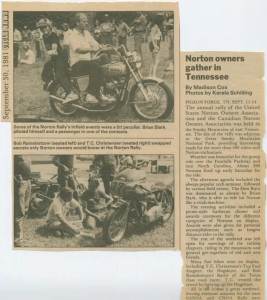
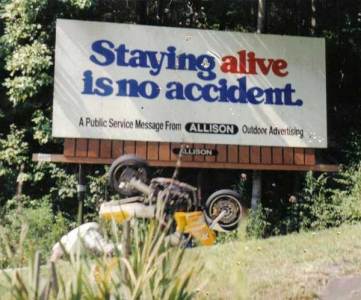
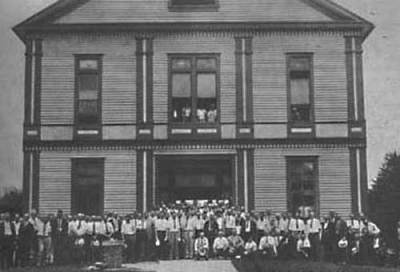
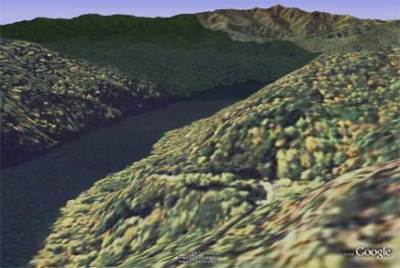
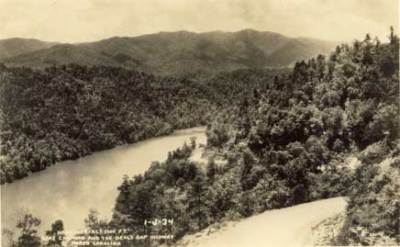
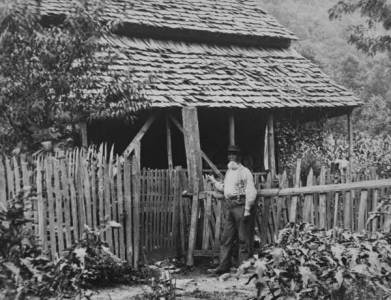
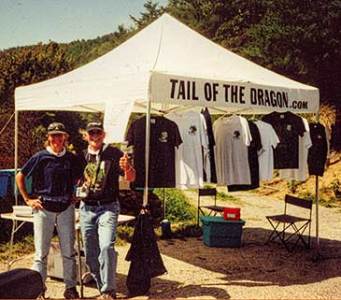
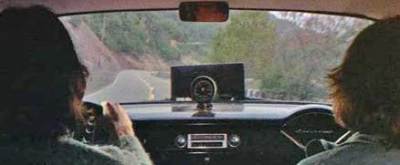
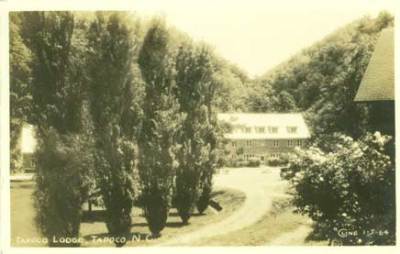
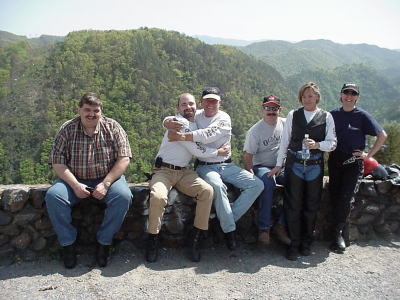
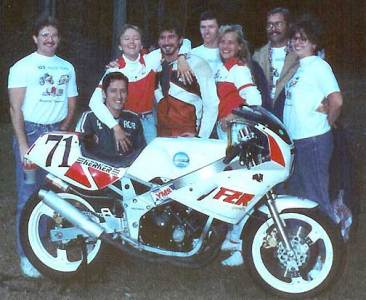
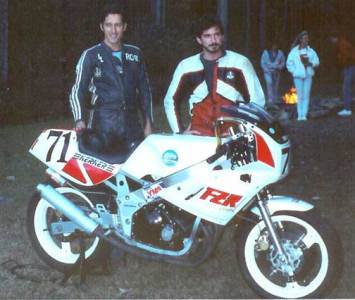
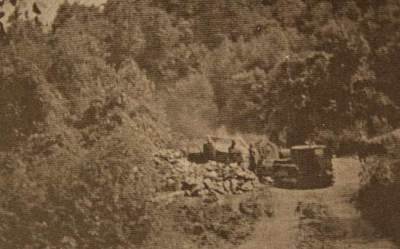
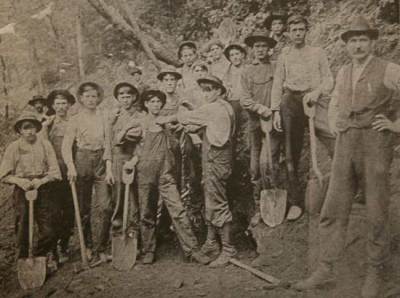
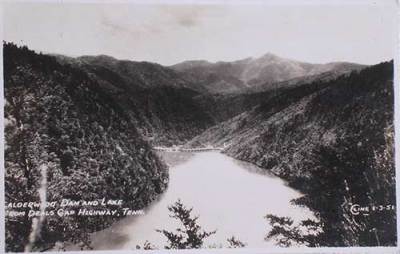
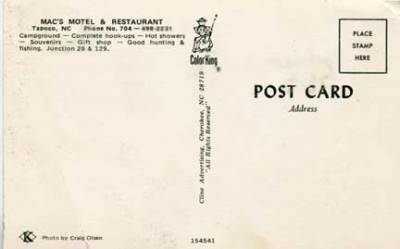
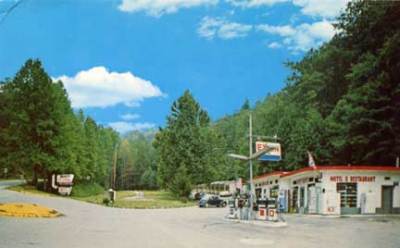
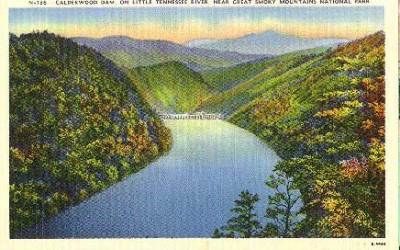
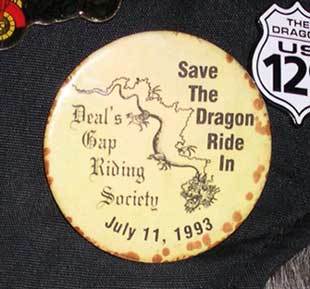
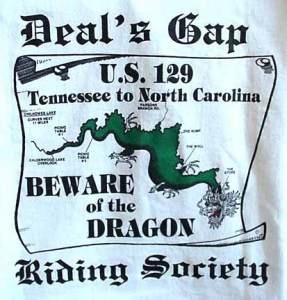
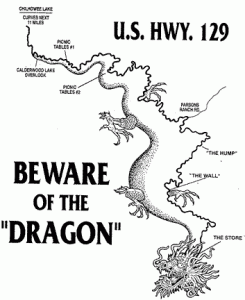
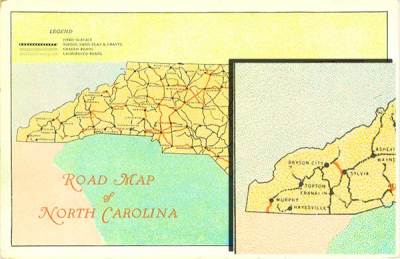
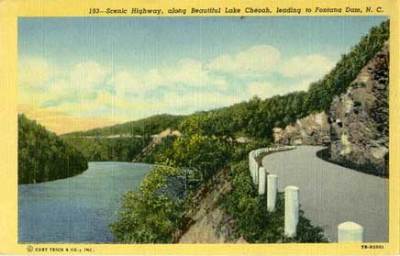
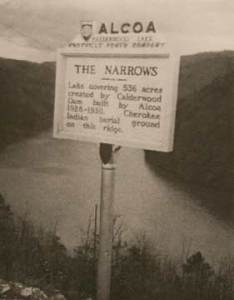

![gap_1982[1] gap_1982[1]](https://tailofthedragon.com/wp-content/gallery/history/cache/gap_19821.jpg-nggid03280-ngg0dyn-400x300x100-00f0w010c010r110f110r010t010.jpg)
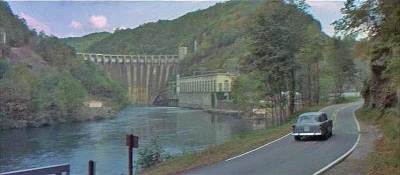
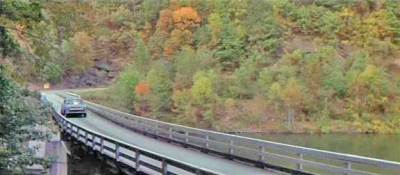
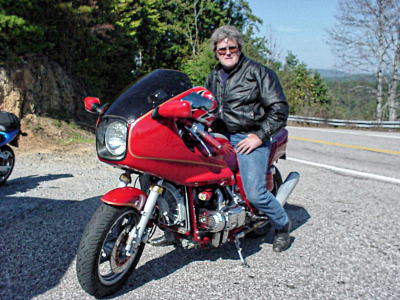
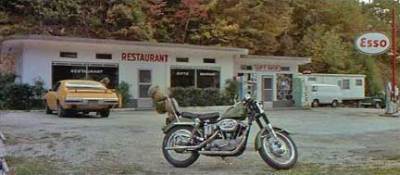
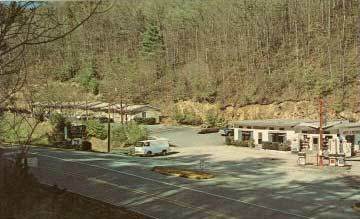
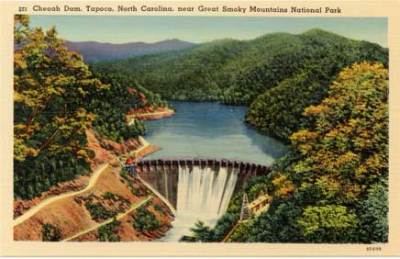
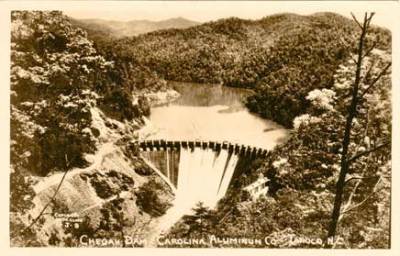
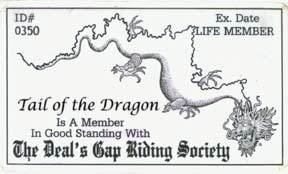
![calderwood-dam-spilling[1] calderwood-dam-spilling[1]](https://tailofthedragon.com/wp-content/gallery/history/cache/calderwood-dam-spilling1.jpg-nggid03270-ngg0dyn-400x300x100-00f0w010c010r110f110r010t010.jpg)
![calderwooddamconstruction[1] calderwooddamconstruction[1]](https://tailofthedragon.com/wp-content/gallery/history/cache/calderwooddamconstruction1.jpg-nggid03269-ngg0dyn-400x300x100-00f0w010c010r110f110r010t010.jpg)
